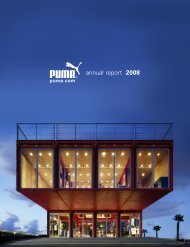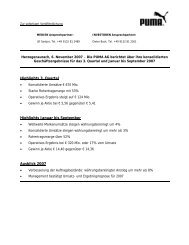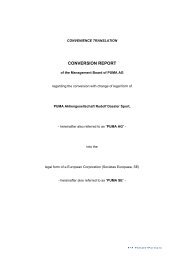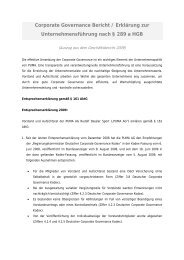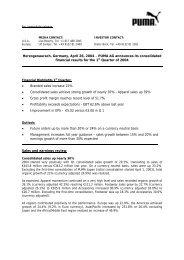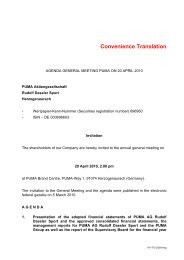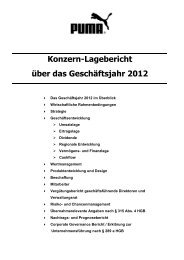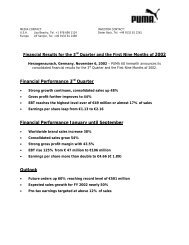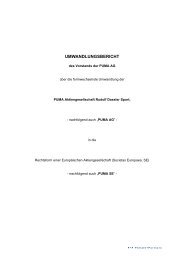PUMA.Safe Environmental Handbook Volume 1 - About PUMA
PUMA.Safe Environmental Handbook Volume 1 - About PUMA
PUMA.Safe Environmental Handbook Volume 1 - About PUMA
Create successful ePaper yourself
Turn your PDF publications into a flip-book with our unique Google optimized e-Paper software.
4.4 Production Related <strong>Environmental</strong> Standards /Manufacturing RSL (MRSL)<br />
In line with <strong>PUMA</strong>’s <strong>PUMA</strong>’s environmental environmental policy and the <strong>PUMA</strong>.Vision, production production related related standards standards for for the the protection protection of of the<br />
environment supplement our Restricted Substances List (RSL) policy and <strong>PUMA</strong>’s own environmental efforts. This part<br />
of the manual is also referred to as Manufacturing or (M) RSL which can be consulted in<br />
in the <strong>Handbook</strong> for<br />
<strong>Environmental</strong> Standards <strong>Volume</strong> 2- Chemical Management.<br />
Management<br />
4.4.1 .1 Soil and ground water protection<br />
Wastewater, chemicals, oils or other toxic liquid substances represent a risk of contaminating minating the soil and ground water.<br />
It is important to avoid migration of any of these liquids into the ground (see Figure 12) 12 or the aquatic environment.<br />
Those hazardous and toxic substances must be stored in a secondary containment. Factories must ensure that storage<br />
areas and containers are designed and operated to minimize minimi e the risk of any releases. To achieve this safeguard, storage<br />
areas should be located away from watercourses and sensitive boundaries, as well as avoid being adjacent to areas of<br />
public use and they should be protected against vandalism. These storage areas areas should be clearly marked, marked<br />
signed and<br />
containers should be clearly labelled. All factories are urged to to not not exceed the maximum storage capacity capacity of of their<br />
their<br />
storage areas. It is important that containers be regularly inspected. The whole storage area should be built as a<br />
secondary containment, for for example example by using using special special paint paint to to make make the floor impermeable and building building surrounding<br />
surrounding<br />
bund walls. Alternatively, when hen secondary containment installations are not possible, protection trays may be used for<br />
all containers. It It is the the producer’s obligation to have emergency emergency plans plans ready ready in in the the event of of accidents accidents or cases of<br />
of<br />
damaged or leaking containers.<br />
The storage of open containers, even if empty, in an outside area should be avoided. Otherwise rainwater might mix<br />
with the the rest rest of of the the chemicals chemicals and and contaminate contaminate the the soil, ground water or adjacent adjacent water-bodies. water<br />
Any storage must be<br />
bounded and sealed, as explained above.<br />
Figure 12: Migration of f toxic toxic substances substances into into the groundwater, prevention through through secondary containment<br />
33





